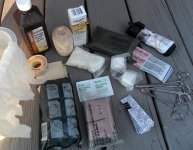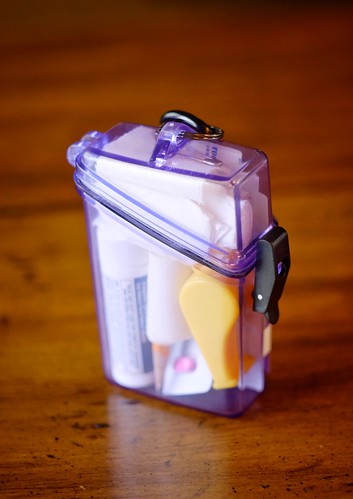Dave_W
Moderator
Staff member
Let's talk first aid.
I've long been a devotee of carrying a good first aid kit. While there are many well designed and equipted FA kits available for sale, I've usually put mine together. I keep this FA kit in my car at all times and use it to stock a small, zip-lock bag FA kit that stays in my fishing vest. Such FA kits allow for quick treatment of the typical cuts and scrapes common to fishing trips but also the contingency of a more serious injury. Even small cuts and nicks, when exposed to dirty rocks with bird poop or stream water can get infected. A good FA kit can save a fishing trip.
My small vest bag FA kit in my vest includes:
-about a half dozen band-aids
-A larger gauze bandage
-A couple alcohol wipes
-A couple aspirin
In my larger FA kit in the car I have the following in a plastic bin(see pic below):
-More band-aids
-Antiseptic cream (Neosporin or Bacitracin)
-A bottle of Hydrogen Peroxide
-Alcohol wipes
-Aspirin and Ibuprofen
-Tourniquet
-Large wound military style bandage
-Hemostats, scissors, tweezers
-Latex gloves
-Gauze rolls
-Ace bandage
-Larger sized band-aids
-FA tape
Hopefully, a FA kit is one of those things that get less rather than more use, but I'm always secure in knowing I have one close by. If you don't have a FA kit, or haven't examined it lately, it might be a good time to inventory your FA kit.
So what do you have in your FA kit? Would you add or remove anything to or from my list? How do you store or carry your FA kit or materials when fishing?
I've long been a devotee of carrying a good first aid kit. While there are many well designed and equipted FA kits available for sale, I've usually put mine together. I keep this FA kit in my car at all times and use it to stock a small, zip-lock bag FA kit that stays in my fishing vest. Such FA kits allow for quick treatment of the typical cuts and scrapes common to fishing trips but also the contingency of a more serious injury. Even small cuts and nicks, when exposed to dirty rocks with bird poop or stream water can get infected. A good FA kit can save a fishing trip.
My small vest bag FA kit in my vest includes:
-about a half dozen band-aids
-A larger gauze bandage
-A couple alcohol wipes
-A couple aspirin
In my larger FA kit in the car I have the following in a plastic bin(see pic below):
-More band-aids
-Antiseptic cream (Neosporin or Bacitracin)
-A bottle of Hydrogen Peroxide
-Alcohol wipes
-Aspirin and Ibuprofen
-Tourniquet
-Large wound military style bandage
-Hemostats, scissors, tweezers
-Latex gloves
-Gauze rolls
-Ace bandage
-Larger sized band-aids
-FA tape
Hopefully, a FA kit is one of those things that get less rather than more use, but I'm always secure in knowing I have one close by. If you don't have a FA kit, or haven't examined it lately, it might be a good time to inventory your FA kit.
So what do you have in your FA kit? Would you add or remove anything to or from my list? How do you store or carry your FA kit or materials when fishing?





